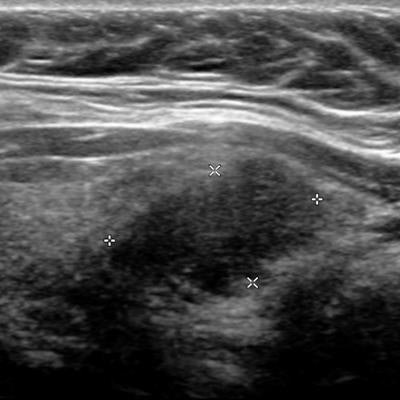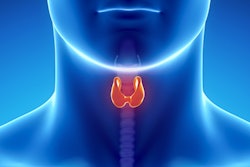
The echogenicity of solid thyroid nodules is often assessed qualitatively during evaluation on ultrasound. But this task can also be performed quantitatively, potentially offering a useful tool for determining malignancy risk, according to research presented at the RSNA 2017 meeting in Chicago.
In a retrospective study, researchers from the University of Rochester in Rochester, NY, found that malignant thyroid nodules had a lower average ratio of nodule mean intensity to background thyroid parenchyma when compared with benign nodules. While it can't be relied upon as a single measure for characterizing these nodules, the method does demonstrate the potential of quantitative techniques for improving classification performance, according to the authors.
"The study underscores the transition in the field from qualitative to quantitative [assessment] as a way to add value," said presenter Dr. Zachary Nuffer, who received a Student Travel Stipend Award from the RSNA for the research.
Thyroid nodule echogenicity
Echogenicity refers to a nodule's reflectivity relative to adjacent thyroid tissue and cervical strap musculature. Traditional qualitative assessment of nodule echogenicity has been performed to observe whether a nodule is hyperechoic, isoechoic, or hypoechoic compared with the surrounding thyroid tissue or, in the case of hypoechoic nodules, the adjacent strap muscles, Nuffer said.
Echogenicity assessment has been incorporated into most major sonographic criteria for thyroid malignancy, including the American College of Radiology's Thyroid Imaging Reporting and Data System (TI-RADS), Nuffer said, which assigns points based on the following criteria:
- 0 points: Anechoic nodule
- 1 point: Hyperechoic or isoechoic nodule compared with adjacent parenchyma
- 2 points: Hypoechoic nodule
- 3 points: Very hypoechoic nodule -- more hypoechoic than strap muscles
Five other sonographic findings are similarly considered. The higher the overall TI-RADS score, the higher the risk the nodule is malignant.
 A malignant thyroid nodule (top) that is very hypoechoic and has a lower ratio of nodule echogenicity to parenchymal echogenicity than a benign nodule (below). All images courtesy of Dr. Zachary Nuffer.
A malignant thyroid nodule (top) that is very hypoechoic and has a lower ratio of nodule echogenicity to parenchymal echogenicity than a benign nodule (below). All images courtesy of Dr. Zachary Nuffer.As part of a larger radiomics project using deep learning to predict thyroid nodule malignancy, the researchers sought to quantify the relationship between solid thyroid nodule sonographic echogenicity and malignancy. They performed a retrospective study involving 69 patients with 35 biopsy-proven malignant solid thyroid nodules and 34 biopsy-proven solid thyroid nodules.
After all nodules were segmented in longitudinal and sagittal planes, the researchers used Adobe Photoshop to calculate the mean intensity of each nodule on the best image of both planes and then averaged the results to arrive at the final mean intensity value. Similarly, they also obtained the mean intensity value of a sample of background thyroid parenchyma adjacent to each nodule in both planes and averaged the results to obtain the mean intensity value. A ratio was then calculated between the nodule intensity and adjacent thyroid parenchyma intensity.
Nuffer noted that many of the nodules in this study had halos, which can affect the echogenicity of the nodule. A halo around a well-marginated hypoechoic or isoechoic nodule is typical of a follicular adenoma. However, a halo is absent in more than 50% of benign nodules, and up to 24% of papillary thyroid carcinomas may have a halo. If present, the halo was incorporated into the overall assessment of nodule echogenicity during the study, Nuffer said.
A significant difference
The average ratio of mean nodule intensity to mean adjacent thyroid parenchyma intensity differed significantly (p = 0.015) between malignant and benign nodules, the researchers found.
| Difference in thyroid nodule intensity on ultrasound | ||
| Malignant nodules | Benign nodules | |
| Average ratio of mean nodule intensity to mean adjacent thyroid parenchyma intensity | 0.73 | 0.86 |
| Standard deviation | 0.21 | 0.23 |
"However, the actual standard deviation is pretty high, so you really can't get outside of one standard deviation above the mean [to make a diagnosis]," he said. "But that's about what I would have expected given the fact that we know that echogenicity alone, like any single thyroid nodule feature, is not sensitive or specific enough to make a diagnosis. Nevertheless, this tells you more closely how accurate echogenicity is with respect to the overall thyroid findings."
It's possible that a larger sample size may have increased accuracy, he said.
"However, I doubt the results would be that different, as the significance was very high and I do not think the standard deviation would narrow that much," he said.
The findings highlight the potential for quantitative analysis to add value in radiology, according to Nuffer. For example, a "taller-than-wide" nodule shape is another qualitative finding that's currently considered during ultrasound assessment of thyroid nodules.
"Should you quantify each of these different [qualitative] parameters and combine them, I think you'd have a much more accurate system for classifying thyroid nodules," he said.




















